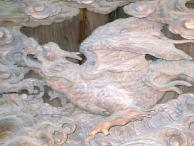|
 One of the absolute must-sees of Japan is Kamakura, and it's only a short hour's train ride south of Tokyo. So, with some time to kill on our winter break, we headed south to check it out. It was a beautiful and clear winter's day, and perfect for taking in the sights of Kamakura. Although Kamakura's a major tourist attraction, it seems we hit it during a lull, while all the temples were preparing for Hatsumode, the first temple visit of the New Year. One of the absolute must-sees of Japan is Kamakura, and it's only a short hour's train ride south of Tokyo. So, with some time to kill on our winter break, we headed south to check it out. It was a beautiful and clear winter's day, and perfect for taking in the sights of Kamakura. Although Kamakura's a major tourist attraction, it seems we hit it during a lull, while all the temples were preparing for Hatsumode, the first temple visit of the New Year.
Kamakura was, for a brief period (1192-1333), the capital of Japan. As with many of Japan's former capitals, temples and shrines are ubiquitous and it can be difficult to visit all of them in one day. We managed to pay more extensive visits to two of them.
The first we visited was Engaku-ji, conveniently located next to the Kita Kamakura train station. Engaku-ji is apparently the number two Zen Temple in the area. It was created in remembrance of all who died in the battle when the Japanese successfully staved off the second Mongolian invasion under Kubla Khan (it is said that during these invasions, the Mongols were driven back by spirit winds, hence the term kamikaze.) Interestingly enough, these invasions took an economic toll on both the Mongols and the Kamakura shogunate, contributing to the decline of both powers. As we walked around, the temple seemed relatively quiet and peaceful, and the surroundings were beautiful.
After exiting past the fall-colored leaves at the entrance to Engaku-ji, we walked about a mile or two down a road to the number one Zen temple in Kamakura, Kencho-ji. It's the oldest Zen training monastery in Japan. Zen Buddhism was imported to Japan from China during the twelfth century, and quickly caught on among the samurai class. At least two of the structures at this site were relocated from the leading zen temple in Kyoto.
 As the daylight was beginning to fade, we quickly walked the extra mile into town and over to the Kamakura train station, and took a small local train over to the site of the Daibutsu (Big Buddha). This is the most famous sight in Kamakura. It's a 40 foot high bronze representation of the Buddha of salvation, second in size only to the Buddha located at Todai-ji in Nara (which may have been the inspiration for this one). This particular statue was cast in 1252 and was originally housed inside a large hall that was swept away by a tsunami in 1495. So, it's been exposed to the elements for over five-hundred years. As the daylight was beginning to fade, we quickly walked the extra mile into town and over to the Kamakura train station, and took a small local train over to the site of the Daibutsu (Big Buddha). This is the most famous sight in Kamakura. It's a 40 foot high bronze representation of the Buddha of salvation, second in size only to the Buddha located at Todai-ji in Nara (which may have been the inspiration for this one). This particular statue was cast in 1252 and was originally housed inside a large hall that was swept away by a tsunami in 1495. So, it's been exposed to the elements for over five-hundred years.
We saw many people taking pictures, and inhaling the incense in front of the statue. We even observed a priest perform a ritual incantation. The Buddha's slippers hang on a nearby wall (I think he wears about size 40's). We spent about an hour here just taking in the scene, before returning on the local train to the Kamakura station and grabbing a bite to eat at one of our favorite izakaya. |
|

